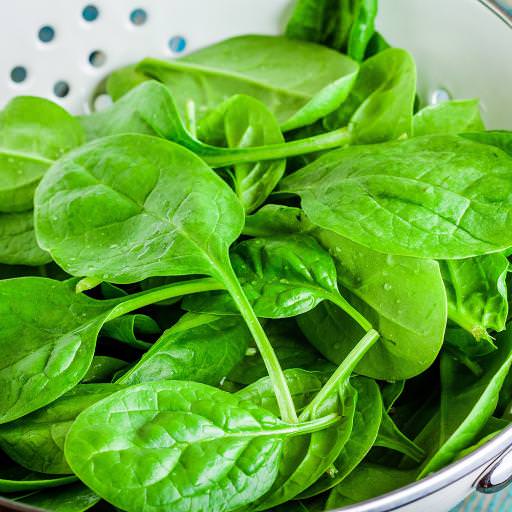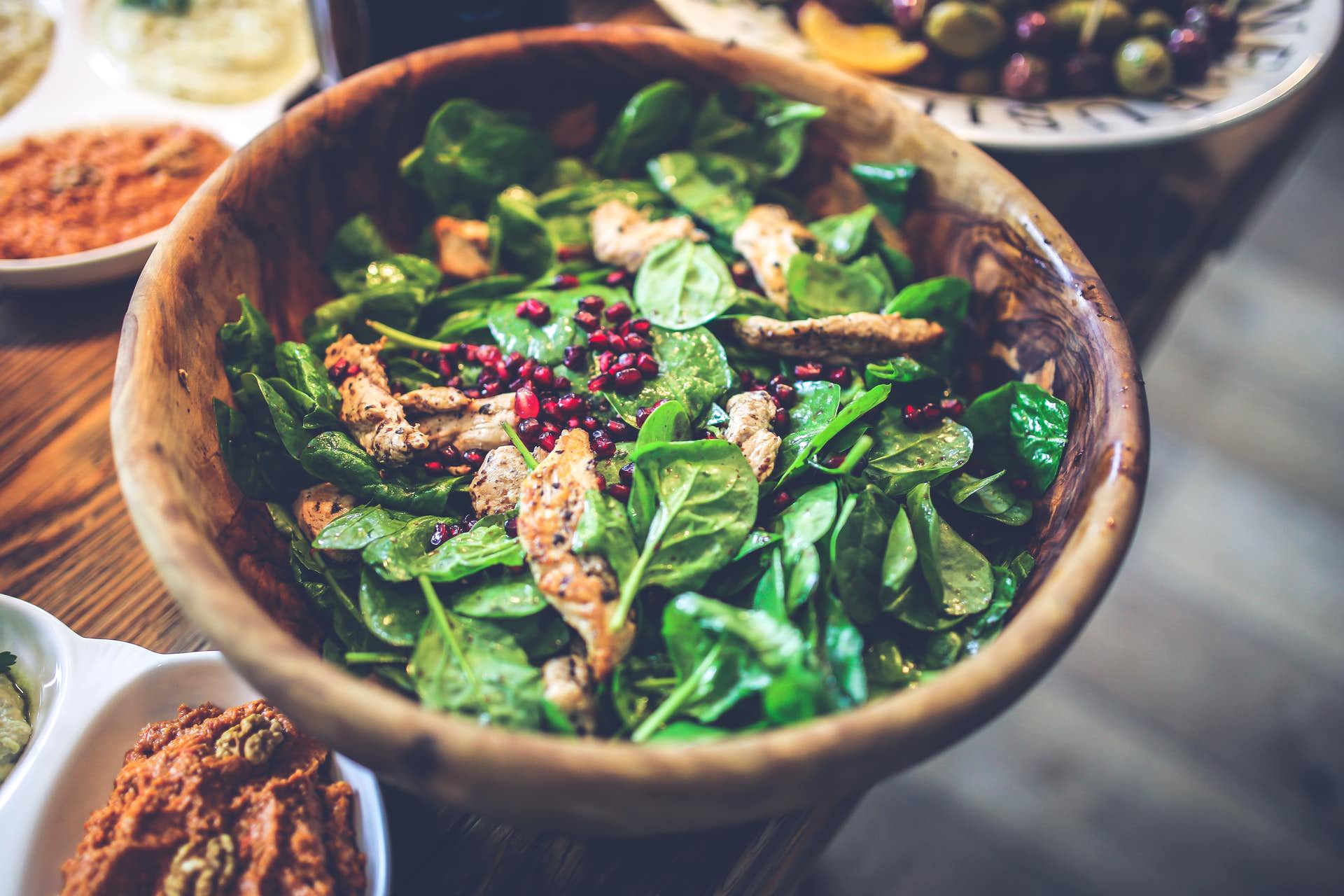Spinach Health Benefits and Side Effects
Written by: Christopher Karam | ✔️ Medically Reviewed by: Dr. Riad M., M.D - G.P and Micheal B., M.D | Last Updated: 2020 April 27
Table of Contents
- Break Down
- Health Benefits
- Side Effects
- Nutrition Facts
- Recommendation
- Frequently Asked Questions (FAQ)
- Related Articles
- Sources
- Buy Spinach Now (US)
Break down and Background
Spinach is a healthy leafy green vegetable that’s heavily consumed around the world for its vitamins, minerals, protein, and fiber.
Whether they're dehydrated, chopped, fresh, or just eaten raw, baby spinach leaves are always edible, healthy, and very nutritious.
Spinach is also a commonly found leafy green plant whose leaves are eaten in various forms. In multiple styles of cuisine, it’s usually paired with olive oil and freshly ground black pepper due to their complementing flavors.
The amazing health benefits of spinach are due to all of the powerful antioxidants and nutrients. Often harvested annually, but could be delayed for up to 2 years in some rare cases.
Spinach has become popular because of its subtle taste and critical role in traditional home-cooked meals, recipes, and healthy living for the typical Chinese family.
Because spinach is packed with various health benefits and nutrition, adding 1 large cup in your savory breakfast or dinner recipes is enough to satiate a whole family of 5.
China is the world’s largest cultivator of spinach. In 2016, it was accredited with cultivating around 92% of the total quantity, globally.
Spinach is often used to prepare foods such as salads as well as sandwiches. When used in salads they’re usually frozen beforehand, this makes them crisper, tastier, and slightly greener.
They’re heavily complimented when used with an olive oil dressing. And when making sandwiches, it's often used instead of lettuce.
It’s also believed that the cultivation of the plant had begun from the ancient Persian era. Leafy green vegetables, including spinach, were first introduced to Sicily by the Saracens in 827 AD to both England and France by the Spanish.
Previously in England, spinach was known as “The Spanish Vegetable” while the Chinese called it “Persian Greens”. Over the years and through translation it was later simplified.
Spinach plants were first introduced to the Chinese in the seventh century by Nepal, and later to the Moors. Spinach plants were introduced to the Spanish in the eleventh century.
The reason for the popularity of the spinach plant in Europe was based on two factors.
The first reason is, spinach starts to appear in the early season of spring and can provide larger yields. At that time, most other foods and vegetables are not readily available.
This made it so that spinach was one of the best resources of vegetables that are nutritionally dense, filled with health benefits, and had very few side effects during those periods.
The second reason is, there were Lenten dietary restrictions (lent) in the 14th century which made a lot of people abstain from having anything other than home foods and dishes.
The first known English cookbook is titled “The Forme of Cury”. The first time the name “spinach” appeared in this book was in the version revised in 1930, it was referred to either “spinnedge” or “spynoches”.
It even helps boost your eye health, lower blood pressure levels, and minimize oxidative stress. The United States Department of Agriculture (USDA) recommends that Americans should consume around 2 ½ pounds annually, which is 0.4 cups a month.
This was not the case for the last forty years. This is almost four times more than the previously recommended amount of spinach consumption.
This can be credited to the impressive breakthroughs in the fields of dieting and medical testing that’s been presented recently, as well as the advancement in health and nutritional research.
Studies have shown that it can help minimize people who suffer from high blood pressure, improve bone health, reduce the risk of heart disease and age-related macular degeneration.
Mostly linked to the powerful antioxidant known as alpha-lipoic and its high levels of magnesium.
It’s especially popular among baby boomers and generation X because it was the vegetable consumed by Popeye, an old cartoon character who eats a cup of spinach to become strong.
Parents often leverage this and encourage their children to eat more so that they can follow his footsteps to grow to be big and strong as the character.
Its popularity also increased during World War I. This is because the juice from the plant was mixed with white and red wine which was used to help French soldiers who had been weakened by hemorrhage.
The list of different species of spinach plants (Spinacea Oleracia) are:
Malabar spinach
Flat-leaf spinach
Smooth spinach
Baby spinach
Savoy and Semi-savoy spinach
Spinach Health Benefits
Organic spinach has numerous health benefits. This is primarily because of the nutrients and the excellent amount of vitamin K found in the leaves.
Spinach contains a lot of calcium, iron as well as carbohydrates, protein, and fat. Although it mostly contains water which accounts for 92% of the volume of raw spinach.
1. Spinach Is Full of Vitamins and Nutrition
Whether you consume boiled or fresh spinach, it’s dense in nutritional value. Containing only 23 calories per 100 grams (3.5 oz).
It also contains vitamins vital for a healthy body such as vitamins A, vitamin B6, vitamin E, vitamin C, vitamin K, and Riboflavin.
There are many other key nutrients needed by the body such as manganese, magnesium, potassium, dietary fiber, and folate that are also present in spinach, that’s the source of all of its health benefits.
It’s also one of the best vegetable sources for increasing your intake of phosphorus, copper and other necessary minerals for a healthy diet, this also helps in preventing the oxidization of cholesterol.
This reduces the number of free radicals in your body, which can potentially be cancerous and harmful to your overall health.
Free radicals damage DNA strands, increase metabolic ageing, as well as suppresses and weakens your immune system.
It can also help with the improvement of skin health and immune system function. All of the vitamins and minerals found in baby spinach helps with cleaning and detoxifying every layer of your skin.
Consuming spinach regularly can promote healthy skin tissue as well as improve the strength of your immune system. This is because spinach leaves contain a lot of vitamin C and antioxidants that fight off free radicals.
Vitamin C is a strong antioxidant which is important when it comes to keeping healthy skin and for boosting the functionality and strength of your immune system.
2. Good Source of Iron and Other Minerals
100 grams of spinach contains a large amount of your RDA of iron. Iron-rich foods help your body regulate and lower blood pressure levels.
This makes it an excellent source of iron for people who suffer iron deficiencies or high blood pressure without having any red meat or chicken.
The United States Department of Agriculture’s (USDA) nutrient database shows that 100 grams of cooked spinach contain 2.73 mg of iron. This is higher than 100 grams of ground beef, which contains only 2.49 mg.
Iron produces the red pigment of the blood known as hemoglobin, which transports oxygen to the body cells and tissues.
It’s also a great source of calcium, 100 grams of spinach contains approximately 97 mg of Calcium. Calcium is important when it comes to neural cell signalling and function.
For neurons to signal and function properly, they use calcium ions (Ca(2+)) which benefits and helps maintain your nervous system, heart, and muscle health as well as control.
The body however never gets to absorb more than 5% of this due to the presence of oxalates found in the spinach plant.
3. Excellent Source of Fiber
The spinach plant is also a rich source of fiber. The insoluble fiber present in spinach makes it great for stabilizing high blood sugar levels and suppresses hunger cravings.
Insoluble fiber is full of benefits, as it helps prevent constipation and blockage as food passes through the digestive system and intestines.
Some of the health benefits of insoluble fiber include:
Improved nutrient absorption and digestion
Preventing bowel disease
Improving your gut bacteria health
Lowers cholesterol levels
Helps maintain a healthy body weight and body fat levels
Normalizes bowel movements, softening your stool
4. Improved Blood Clotting
A major health benefit of spinach (while for others this can be a side effect) is the fact that it helps your blood clot. This is because it contains a lot of vitamin K which is essential for blood clotting.
In just a few leaves of spinach, you can get all the vitamin K you need for the day. When feeding a family, you should add a cup to your recipes which would satisfy the vitamin K intake for everyone.
A study published by the University of Linköping has determined that spinach is a rich source of folic acid, oxalic acid, and alpha-lipoic acid. It also contains potassium folate, which is also referred to as vitamin B.
These levels of folic acid, oxalic acid, and alpha-lipoic acid are vital for ensuring normal cellular function as well as tissue growth and regeneration throughout the body.
This proves that it’s vital for optimal health in pregnant women and their children.
5. Improves Eye Health
Spinach also helps with the improvement of eye health and protects the longevity of your vision. This is because it contains Lutein and Zeaxanthin.
It’s been proven that Lutein, Zeaxanthin, and Meso-zeaxanthin in the macula (near the center of the retina) blocks blue light from reaching and damaging the underlying structures in your retina.
Thereby reducing the risk of light-induced oxidative damage that could lead to age-related macular degeneration.
If you are interested in improving the health of your eyes, increasing your spinach intake is at the top of available sources for rounding out your diet.
It’s also a rich source of zeaxanthin. This plant-based compound is similar to lutein because studies have shown that it improves eye health, specifically protecting your retina, macula, optic disc, and choroids.
6. Decreases The Risk of Cancer
Another important health benefit of spinach is that it decreases the risk of cancer as well as other chronic diseases.
Spinach contains a plant-based compound known as kaempferol. Kaempferol is an antioxidant that has proven to reduce the risk of cancer and oxidative stresses and inflammatory age-related chronic diseases.
GDG and SQDG are enzymes which are present in spinach that's been proven to have the ability to slow down cancer growth.
Tumor growth in a human's cervix was reduced by GDG and SQDG in a study carried out to investigate the effectiveness of these compounds against the growth of cancer.
These compounds didn’t only slow down the growth of the tumor, they also decreased the size of the tumor.
Studies have shown that breast cancer has also been proven to be prevented by eating spinach. It has also been proven that spinach consumption leads to a reduced risk of prostate cancer.
7. Spinach Improves Heart Health
Spinach is a powerful superfood that contributes to improved heart health. This is because spinach contains nitrate, there is a high concentration of nitrates present in spinach.
Nitrates are a type of vasodilator which improves blood flow and blood oxygen saturation levels. Vasodilators widen (dilate) the blood vessels, improving blood flow and allowing more oxygen-rich blood to reach the heart muscle.
Nitrates also relax the veins to ease the workload on the heart when blood is returning to the heart from the arms and legs, lowering your blood pressure.
Improving your cardiovascular system also helps slow down the process of macular degeneration, which is nerve damage over long periods, usually effected by diet and ageing.
Spinach also lowers your risk of getting heart disease and improves bone health in younger developing adolescents.
8. Prevents Infections and Inflammation
Spinach is important for the prevention of infection and inflammation because spinach is one of the richest sources of Quercetin.
Quercetin is a strong antioxidant flavonoid that can scavenge harmful chemicals in the body as well as reduce tissue and DNA damage.
9. Prevents Oxidative Stress
Spinach is also known for its ability to prevent oxidative stress.
This is because the various antioxidants present in the plant ensures this during the metabolism process, the byproducts of these processes are called free radicals.
Free radicals are harmful to the body because they can cause oxidative stress. The danger of oxidative stress is that it causes various side effects such as faster ageing, weakening internal organs, higher risks of cancer, heart diseases, and diabetes.
Apart from this oxidative stress also leads to an increase in the risk of cancer. Multiple studies using both humans and animals confirmed that spinach can reduce oxidative stress.
In a controlled study involving 8 people, spanning over 4 weeks the benefits of the spinach supplements started taking place. Reducing markers of oxidative stress and muscle damage in well trained healthy men.
Spinach Side Effects and Detriments
Spinach has a large list of cooking applications as well, used in French, North American, and Asian cuisines.
If you want to add spinach to your diet there are some considerable side effects to consider, especially when eating too much since it’s really easy to overeat.
The fat-soluble vitamins are A, D, E, and K. If you eat over your recommended daily allowance (RDA) these vitamins will start to get stored as body fat.
1. Inhibits The Absorption of Iron and Calcium
There are substances contained in spinach that are detrimental to the rate at which the body absorbs iron. Although spinach has a lot inside the edges of the leaf, it's still difficult for your body to absorb most of it.
These substances are called oxalates. Oxalates are renowned for their ability to bind to iron and form a compound called ferrous oxalate. Ferrous oxalates are bad to your body because they are capable of ridding the body of essential minerals, especially when your body is full of these oxalates.
These present oxalates inhibit the absorption of iron by the body and prevent the absorption of calcium. This makes the calcium available in spinach almost irrelevant because only about 5% gets absorbed.
2. Increases The Development of Kidney Stones
Small acids and mineral salt buildup are responsible for kidney stones. One of the most common types of kidney stones is the one that consists of calcium stones. Calcium stones are mostly made up of calcium oxalate.
People who consume large amounts of spinach are at risk of developing kidney stones. This is because it contains a high amount of both calcium and oxalates.
3. Spinach Increases Blood Clotting
The anti-blood thinner vitamin K1 is highly present in spinach, this increases and accelerates the process of blood clotting, preventing any additional blood loss during injuries, surgery, or clinical disorders.
This is beneficial for preventing excess loss of blood when there’s internal or external bleeding. This, however, becomes detrimental to one’s health especially for people who are taking and rely on blood-thinners, such as Warfarin.
Patients using blood-thinning medications should avoid most leafy green vegetables altogether as most of them contain a large amount of vitamin k. which includes spinach.
Rating and Recommendation
Extremely Recommended
Without any controversy, few plants can match the nutritional profile of spinach. Some of the health benefits include the prevention of cancer, prevention of oxidative stress, reduce the risk of type 2 diabetes, and the improvement of eye and heart health.
It’s highly recommended to add spinach to your daily diet, for anyone looking to improve their overall health in many different areas. It is, however, important to note that spinach also has some side effects, especially when taken in high doses, which is very easy to do.
Cooking with too much spinach can be detrimental to your health through the inhibition of the absorption of Calcium as well as Iron with the possibility of causing kidney stones, and in rare cases, some people have experienced allergic reactions.
The relevance of these side effects is a result of consuming too many spinach leaves. To maximize the health benefits of spinach and minimize the side effects you shouldn’t consume more than 30 to 40 grams per day.
Spinach should be consumed daily, but in small amounts. Failure to do this will make your spinach intake cause more damage than the intended good which is usually the reason why some people would consume spinach in the first place.
Here’s the list of the 9 health benefits of spinach:
Full of Vitamins and Nutrition
Good Source of Iron and Other Minerals
Excellent Source of Fiber and Protein
Improved Blood Clotting
Improves Eye Health
Decreases The Risk of Cancer
Spinach Improves Heart Health
Prevents Infections and Inflammation
Prevents Oxidative Stress
Here’s the list of the 3 side effects of spinach:
Inhibits The Absorption of Iron and Calcium
Increases The Development of Kidney Stones
Spinach Increases Blood Clotting
It’s best consumed fresh because it will lose a lot of its nutritional value with the other methods of storage, even more so after just a few days.
However, if you want to store your spinach for a long time, freezing would keep it staying fresh and nutritious for up to 6 months.
Refrigerating spinach can only keep it fresh and nutritious for up to 1 week. Most of its nutrients including folate, beta-carotene, and carotenoid contents will be reduced or completely removed if it's stored or frozen for too long.
There are also many reports of high occurrences of Dichlorodiphenyltrichloroethane (DDT) contamination of the plant, a type of insecticide.
That’s why it's safer to buy only organic varieties of spinach as often as possible. DDT is a common trigger for cancers, birth defects, and reproductive damage.
Detection of products containing DDT has been banned since 1972 in the U.S. but you should still go through all the precautions.
However, DDT is used to fight malaria caused by mosquitoes in certain countries. It's dangerous as it can last for up to 4 years when sprayed in the soil.
Some brands that grow spinach have been growing the plants in soils that contain DDT based on a report by the USDA.
Frequently Asked Questions
Spinach (Spinacia Oleracea) is a healthy, dark, leafy green vegetable originating from Persia. It comes from the family species named Chenopodioideae (as known as Amaranth), which has a similar background to cacti, beets, quinoa, and even carnations.
Spinach is usually eaten whole, including the stems (because that's where all of the fiber resides). It doesn't last long in the fridge before going bad, which is why most people freeze or dehydrate the delicate leaves.
It can either be eating cooked or raw, although the flavor changes substantially after cooking. It's filled with heart-healthy antioxidants. Some are lost during the cooking process due to heat, but it still keeps its large amount of its vitamin K.
Spinach is a versatile vegetable since it can be cooked in many different ways, used in many dishes, and can even be eaten raw.
You can either boil, steam, or saute the leaves. It's most commonly sauteed in a pan with garlic, olive oil, and some form of meat or protein.
Leaving it to cook on medium heat for 5 to 7 minutes will lightly fry and soften the leaflets. Halfway through you can season it with salt, pepper, and parmesan cheese. You can opt-in for crushed garlic or even substitute it entirely for garlic salt.
Alternatively, you can add a few chopped leaflets over any dish to add another layer of flavor, such as over your beef, chicken, tofu, or mixed in with your pasta.
Spinach grows best in humid, moist soil that's rich in nitrogen. Because it takes so long to grow, it's often simply bought in the supermarkets.
Here's how to properly grow a healthy spinach plant in a reasonable amount of time.
1. Its roots grow deep, make sure to soften the soil up to 1 foot deep before planting any seeds. Make sure the soil pH level is between 6.0 to 7.0
2. To have a harvest twice a year plant your seeds 4 to 6 weeks before the last expected cold day of spring. Then 6 to 8 weeks before the first cold day of fall.
3. Space each hole 12 to 14 inches apart to allow it to reach its full size. The depth should be between 1 to 2 inches.
Many retailers sell spinach seeds and plants online and in stores. Amazon, Walmart, and your local gardening supplies store.
Articles and Sources

Spinach Nutrition Facts
Serving Size 100 g (about 3.5 Oz or 0.44 Cups)
| Amount Per Serving | ||
|---|---|---|
| Calories 23 | Calories from Fat 3 | |
| % Daily Value* | ||
| Total Fat 0.4 g | < 1 % | |
| Saturated Fat 0 g | 0 % | |
| Polyunsaturated fat 0 g | ||
| Monounsaturated fat 0 g | ||
| Trans Fat 0 g | ||
| Cholesterol 0 mg | 0 % | |
| Sodium 0 mg | 0 % | |
| Potassium 667 mg | 17 % | |
| Total Carbohydrate 3.6 g | 1 % | |
| Dietary Fiber 2.2 g | 8 % | |
| Sugars 0.4 g | ||
| Protein 2.9 g | ||
| Vitamin A 560 % | Vitamin C 140 % | |
| Vitamin E 31 % | Vitamin K 181 % | |
| Vitamin D 0 % | Vitamin B6 0 % | |
| Magnesium 20 % | Cobalamin 0 % | |
| Calcium 10 % | Iron 21 % | |
Calories per gram:
Fat: 9 | Carbohydrate: 4 | Protein: 4
Source: USDA's Nutrient Database














